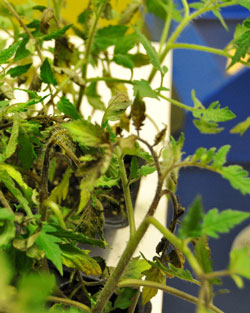Late Blight in Tomatoes
Late blight was confirmed in June of 2010 in Manitoba on seedling tomatoes that were produced in Manitoba. The infected seedlings were being sold at several retail outlets in Winnipeg and Brandon. The infected seedlings that were remaining for sale were destroyed. Infected tomato seedlings are shown in Figure 1.
Plants susceptible to late blight include: potato, tomato, various nightshade weeds and other solanaceous plants. The disease affects all parts of susceptible crops (i.e. foliage, fruit, tubers, etc). Late Blight spores are microscopic and they are dispersed by the wind.
An infected tomato seedling with profuse spore production is shown in Figure 2.

Figure 1: Infected Tomato Seedlings June, 2010 (Source: MAFRD)

Figure 2: Infected Tomato Seedling June, 2010 (Source: MB ARD)
In organic cropping systems, if there is no late blight present in the crop, growers can use organically approved copper-based products as a preventative measure. There are no effective organic control measures available for late blight if it is confirmed in the crop. If the disease is confirmed in an organic field, it is prudent that the crop be destroyed in order to prevent the disease spreading.
Commercial producers with suspected late blight infected plants can send samples for identification to Manitoba Agriculture and Resource Development Crop Diagnostic Lab, 545 University Crescent, Winnipeg, MB or via your local ARD/MASC Service Centre
In a garden situation, if diseased plant material was thrown out or composted it is still able to produce spores which could be transmitted on the wind and drift onto susceptible plants in the area. Double-bagging the diseased material with plastic bags helps keep the spores from spreading and infecting healthy plants. Set the bags in the sun so as to heat the infected material inside enough to kill the plants. As long as there is still fresh and green material the plants are still feeding the late blight fungus, which will go on producing spores until the plant tissue is entirely dead.
Resource Link:
Diagnostic images from Cornell University, College of Agricultural and Life Sciences

